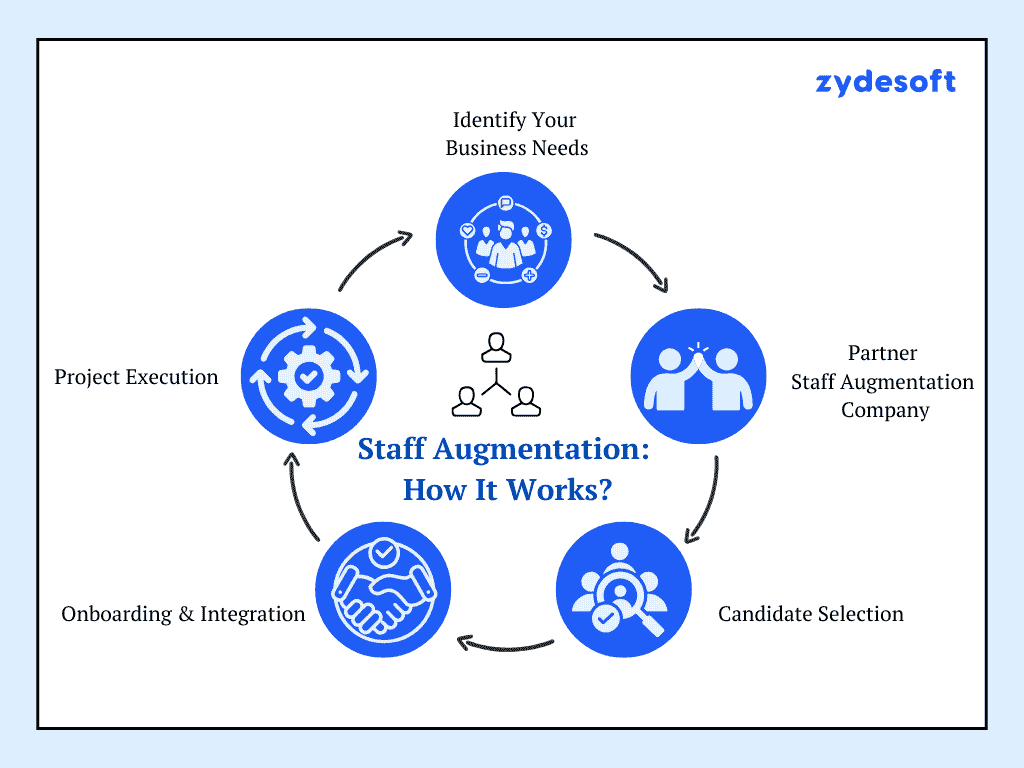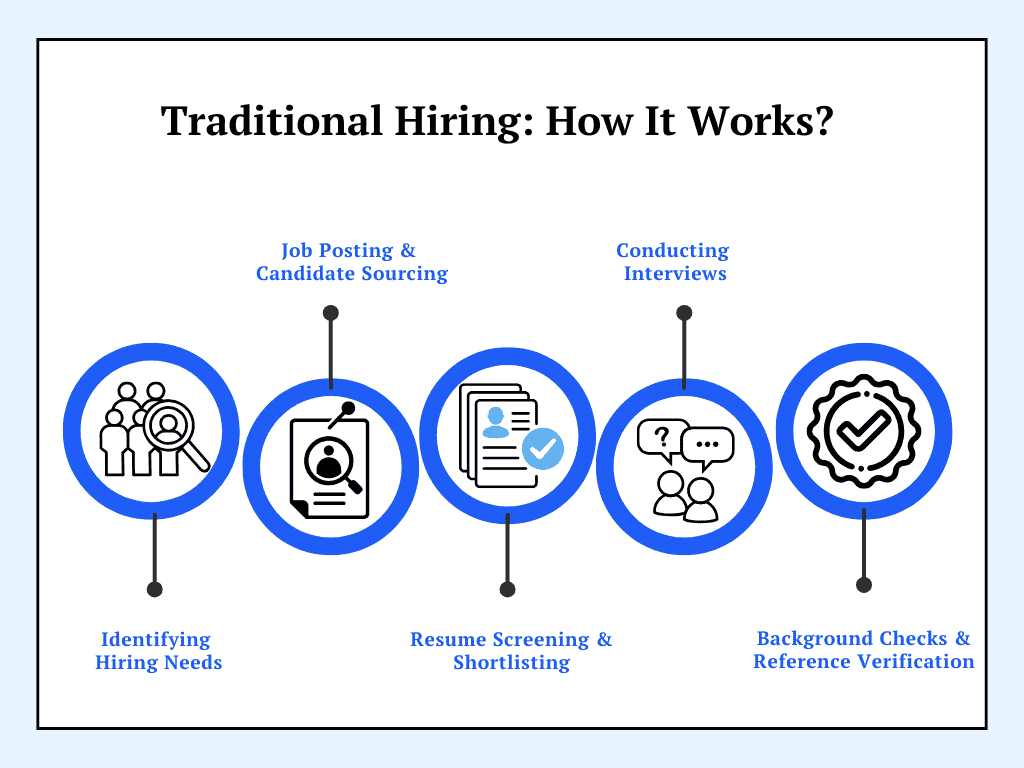
Finding the right talent has never been more challenging or more critical for businesses. Companies need to move faster and manage huge projects within a short time, but the demand for experienced talent is slowing them down. Whether you need a developer for a 6-month project or a long-term addition to your team, choosing the right hiring approach can help your business move forward smoothly.
That’s where two popular models provide the best solution that is staff augmentation and traditional hiring. Both can help you build a capable team and choosing the right approach can ensure smooth project delivery, meet deadlines, cost savings, and simplify the hiring process
This article explains everything clearly. You’ll learn about:
Staff Augmentation is a flexible hiring model where businesses hire skilled developers from an external provider to support their team with top talents. It is often used to fill skill gaps, hire top talents for projects, manage workloads, and reduce hiring risks. Unlike traditional hiring, employers can hire highly skilled and vetted developers within a short duration. When you hire candidates through traditional hiring, you need to spend more costs for advertising and you have to check more resumes to filter the right candidates for your company goal. Staff Augmentation is the best approach to help companies quickly scale their workforce without the lengthy recruitment process. Staff augmentation vs traditional hiring is a common comparison businesses make when deciding between flexibility and long-term staffing for their business needs.

1. Identify Your Business Needs:
A business determines the skills, experience, and number of professionals required to complete a project or fill a talent gap.
2. Partner Staff Augmentation Company:
Companies often work with a staffing agency or an IT service provider specializing in staff augmentation because staff augmentation providers have a pool of pre-vetted talent ready to work on your projects quickly.
3. Candidate Selection:
The provider shortlists professionals based on your requirements. You can review profiles, conduct interviews (if needed), and select the best fit for your team.
4. Onboarding & Integration:
Once selected, the professionals are onboarded and integrated into your existing team. They work under your supervision, following your company’s processes and timelines
5. Project Execution:
The augmented staff works alongside your in-house team to complete the project or handle ongoing tasks. You maintain full control over the work, while the provider handles administrative aspects like contracts and payroll.
Example:
Suppose a fintech startup faces a skill gap in blockchain developers and immediately needs a professional blockchain developer for their team. In that case, they can use staff augmentation to quickly onboard experts without the lengthy hiring process.
Traditional hiring is the conventional process organizations use to recruit full-time employees, typically for in-office roles. It follows a structured approach, including job postings, resume screening, interviews, background checks, and onboarding. This method is widely used by businesses that require employees to work on-site and prefer a thorough evaluation before making hiring decisions. The process can take weeks or even months, depending on the role and company policies. Expenses include job ads, recruiter fees, HR team salaries, and administrative costs. Candidates are typically expected to work on-site, limiting access to a broader talent pool. Traditional hiring is generally focused on permanent employment rather than short-term or contract-based work.

Here’s a clear and easy-to-understand comparison table for Staff Augmentation vs Traditional Hiring – Pros and Cons:
| Factor | Staff Augmentation | Traditional Hiring |
| Geographical Reach | Global access, no relocation needed | Limited to local talent, relocation required |
| Hiring Costs | Lower costs, no benefits required | Higher costs (salary, benefits, office space) |
| Time-to-Hire | Fast onboarding, pre-vetted candidates | Lengthy recruitment process |
| Time Zone Flexibility | 24/7 support, global coverage | Restricted to local work hours |
| Scalability | Easily scale up your team with top talents | Fixed workforce, complex layoffs |
| Team Integration | It may require remote collaboration tools | Stronger alignment with company culture |
This table clearly shows the staff augmentation vs traditional hiring pros and cons, helping businesses make the right choice based on their needs. Does this work for you?
CTA Button: Scale Your Team with IT Staff Augmentation
Choosing staff augmentation or traditional hiring depends on different factors. Here are some common challenges to keep in mind:
| Factor | Traditional Hiring | Staff Augmentation |
| Payroll Management | Handled internally by the company’s HR and payroll department. | Managed by the vendor or staffing agency. |
| Employee Benefits | Includes health insurance, retirement plans, paid leave, etc. | Not required – benefits are the vendor’s responsibility. |
| Tax Obligations | The company is responsible for employee taxes and deductions. | Vendor handles tax-related matters for augmented staff. |
| Compliance | The company ensures labor law compliance, contracts, and policies. | The vendor ensures compliance; the company focuses on work management. |
| Contract Type | Permanent employment contracts. | Service agreements with the vendor, workers remain vendor employees. |
| Legal Risks | Higher legal responsibility for employee disputes and liabilities. | Lower legal risk, the vendor handles employment-related issues. |
This table simplifies the payroll and legal considerations in traditional hiring vs staff augmentation, helping businesses understand the responsibilities and risks involved in each model. Does this cover what you need?
Choosing between staff augmentation or hiring full-time employees depends on your business goals, project needs, and long-term plans.
Some businesses find success with both staff augmentation and traditional hiring. You can use staff augmentation to meet urgent needs, need specialized tasks, or handle workload rises while hiring full-time employees for roles critical to long-term success. This hybrid approach allows you to stay flexible while building a stable core team.
When it comes to building a high-performing tech team, staff augmentation stands out as the most flexible and efficient solution for modern businesses.
While traditional hiring works well for long-term, core roles, today’s fast-moving tech landscape often demands speed, adaptability, and access to specialized skills. That’s exactly where team augmentation services deliver the most value.
With staff augmentation, businesses can:
For companies aiming to innovate faster, meet tight deadlines, and stay ahead in a competitive market, augmenting your team with on-demand experts is often the smartest way forward.
Partnering with the right staff augmentation provider ensures that you get pre-vetted professionals who integrate smoothly with your in-house team, driving results from day one.
As businesses look to the future, flexible models like staff augmentation will continue to shape the success of tech teams.